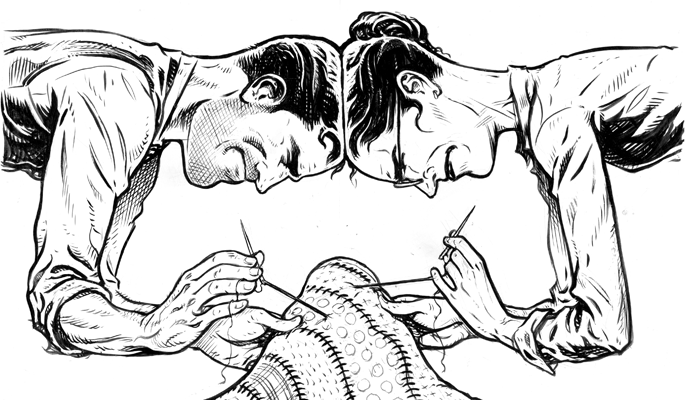In a snappier title, Adam Kahane uses a description of “Collaborating with the Enemy”. A helpful distinction shows up in his 2017 book:
Our conventional understanding of collaboration is that it requires us all to be on the same team and headed in the same direction, to agree on what has to happen and make sure this happens, and to get people to do what needs to be done. In other words, we assume that collaboration can and must be under control. Conventional collaboration looks like a planning meeting.
But this conventional assumption is wrong. When we are working in complex situations with diverse others, collaboration cannot and need not be controlled.
Unconventional, stretch collaboration abandons the assumption of control. It gives up unrealistic fantasies of harmony, certainty, and compliance, and embraces messy realities of discord, trial and error, and cocreation. Stretch collaboration looks like martial arts practice. Stretch collaboration enables us to get things done even in complex situations with people we don’t agree with or like or trust.
Two approaches to collaboration
| . | Conventional Collaboration | Stretch Collaboration |
|---|---|---|
| How we related with our collaborators | Focus on the good and harmony of the team (one superior whole) | Embrace conflict and connection (multiple diverse holons) |
| How we advance our work | Agree on the problem and the solution (one optimum plan) | Experiment our way forward (multiple emergent possibilities) |
| How we participate in our situation | Change what other people are doing (one paramount leader) | Step into the game (multiple cocreators) |
Stretch collaboration requires us to make three fundamental shifts in how we work.
First, in how we relate with our fellow collaborators, we must stretch away from focusing narrowly on the collective goals and harmony of our team, and move toward embracing both conflict and connection within and beyond the team.
Second, in how we advance our work, we must stretch away from insisting on clear agreements about the problem, the solution, and the plan, and move toward experimenting systematically with different perspectives and possibilities.
And third, in how we participate in our situation—in the role we play—we must stretch away from trying to change what other people are doing, and move toward entering fully into the action, willing to change ourselves.
Stretch collaboration is challenging because all three of these stretches require us to do the opposite of what seems natural. Rather than shrink away from complexity we must plunge into it. Often this feels uncomfortable and frightening.
These stretches require us to pluralize: to move away from paying attention only to one dominant whole, one optimum plan, and one superior leader, toward attending to multiple diverse holons (wholes that are part of larger wholes), multiple emergent possibilities, and multiple cocreators.
Getting things done in complex situations with diverse others is never straightforward. Energies must be mobilized; needs must be balanced; actions must be taken. Stretching does not make this work disappear; it just enables us to do it with less fear and distraction and more connection and awareness. The proverb says, “Before enlightenment, chop wood, carry water. After enlightenment, chop wood, carry water.” After enlightened stretching, we still have our work to do, but now we have a better chance of doing it successfully.
This book presents a theory and practice of stretch collaboration.
- Kahane, Adam. 2017. Collaborating with the Enemy . Berrett-Koehler Publishers. https://www.oreilly.com/library/view/collaborating-with-the/9781626568242/. (I happened to find it in the Toronto Public Library ).
For the Systems Changes Learning Circle – when viewing the system of interest as an organization – “conventional collaboration” is more a behavioral systems approach, and “stretch collaboration” is more of an ecological systems approach.
The larger context helps in reading the publicly accessible article:
- Kahane, Adam. 2018. “How to Collaborate When You Don’t Have Consensus.” Strategy+business , no. 92. https://www.strategy-business.com/article/How-to-Collaborate-When-You-Dont-Have-Consensus .

